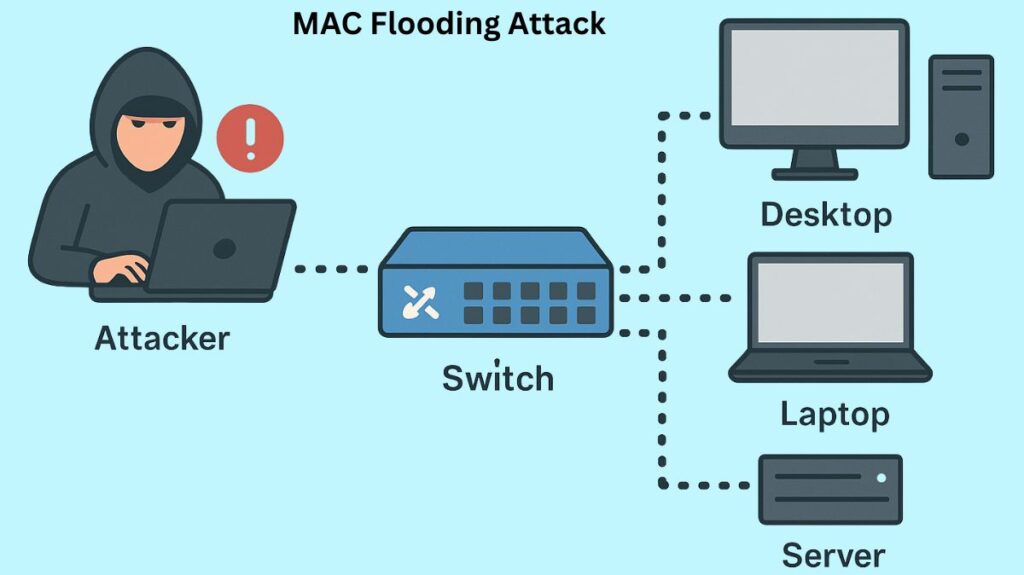What is MAC Flooding Attack?
Network switches are the target of a network security exploit called a MAC flooding attack, sometimes referred to as a CAM table overflow. It is a Layer 2 (L2) attack designed to overload the switch’s internal memory in order to compromise its security.
If a MAC flooding attack is successful, the attacker can potentially compromise data confidentiality by intercepting traffic meant for other devices. Because it exposes the system to attack, this kind of behaviour is a major worry for ethical hackers.

How it Works
The MAC flooding attack takes use of a network switch’s internal address table’s limited capacity to target its functionality.
Normal Switch Operation: A switch functions as a “sorting office,” effectively directing network traffic through the use of a MAC address table (also known as a CAM table). The mappings between the distinct MAC addresses of the devices and the particular physical ports on the switch where those devices are situated are kept in this database. This improves network security and efficiency by enabling the switch to forward traffic only to the designated port (unicast). By looking at the source MAC address of each Ethernet frame it receives, the switch creates this database.
The Attack Phase: The attacker creates and quickly transmits a large number of Ethernet frames to the switch. Each frame in these packets has a distinct, spoof, or random source MAC address because they contain bogus information about the sender’s hardware address.
Table Overflow: The switch rapidly uses up the MAC address table’s limited capacity as it tries to learn and save each of these counterfeit MAC addresses. The switch is unable to learn new, valid MAC addresses once the table is full.
Fail-Open Mode: The switch defaults to a fail-open mode, which functions similarly to a basic Ethernet hub, when the MAC address table is full. The switch switches to broadcast mode, forwarding all incoming traffic (including broadcast and unicast) out of all associated ports, in place of unicast forwarding. The attack gets its name from its broadcasting behaviour.
Data Interception: The attacker can now use a packet analyser or sniffer (such as Wireshark) to record and examine all network traffic meant for other devices because they are linked to one of these compromised ports.
Also Read About Cisco ARP Spoofing Attack Prevention And Detection Guide
Consequences and Risks
A MAC flooding attack’s main objective is to reveal network traffic; however it also seriously impairs operations:
- Attackers have the ability to intercept credentials, such as usernames and passwords, eavesdrop on private conversations, and steal confidential information.
- Network Disruption and Denial of Service (DoS): The attack causes excessive traffic and network congestion by overloading the CAM table and forcing all traffic to broadcast. This can cause slow performance, delays, instability, and even a full denial of service (DoS) for authorised users.
- Facilitation of Other Attacks: More complex exploits frequently use MAC flooding as a prelude or first step. It can be used in conjunction with strategies like credential capture or ARP spoofing. Additionally, it can be applied as a basic VLAN hopping attack.
Prevention Techniques
Setting up security measures on managed switches correctly is crucial to preventing MAC flooding. Important countermeasures consist of:
Port Security
Port security is said to be the most successful defence. In order to limit the maximum number of MAC addresses that switch ports can learn, it is necessary to configure them (e.g., setting the limit to 1 or 2 for end-user ports).
- When the limit is reached, switches can be set up to perform a specified violation action, like restricting (dropping offending frames and generating an alert) or shutting down (disabling the port).
- Another option is Sticky MAC Addressing, which automatically discovers valid MAC addresses and safely stores them in the settings.
VLAN Segmentation
The broadcast domain is constrained when numerous Virtual LANs (VLANs) are used. The potential impact on the entire network is decreased if a MAC flooding attack takes place because the damage is limited to the devices in the affected VLAN.
Dynamic ARP Inspection (DAI)
By enabling dynamic ARP inspection (DAI), one can indirectly identify unusual MAC activity by confirming the integrity of ARP packets.
Storm Control / Rate-Limiting
This stops high-volume spoofing traffic by establishing thresholds to rate-limit incoming frames or ARP/broadcast frames on access ports.
General Precautions
Using strong passwords, installing and upgrading antivirus software, and installing system updates and patches as soon as they are released are further precautions.
Also Read About What Are Layer 2 Switches And How Does Layer 2 Switch Work
